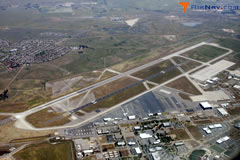 Editorial: Mather Airport master plan charts a reasonable path
Editorial: Mather Airport master plan charts a reasonable path
The future of Mather Airport is a balancing act – between priming an important economic engine and preserving peace and quiet for residents, between doing what’s best for Mather and what’s best for Sacramento International Airport.
The Mather master plan endorsed by Sacramento County supervisors Tuesday isn’t perfect, but it gets close to striking the right balance. And as was made clear repeatedly, the specific projects to bring the airport up to current aviation standards – a runway extension, new hangars and others – would have to be approved separately.
That gives both supporters and opponents ample opportunity to have their say. It gives county officials another chance to make sure each project makes sense, financial and otherwise. It’s unfortunate that the county airport system proceeded on one project – an $800,000 instrument landing system upgrade to make it easier to land in fog – before the master plan had been adopted.
The plan and an accompanying environmental impact report sketch out what county leaders hope will happen through 2035 at Mather, a former Air Force base turned over to the county and converted into a civilian airport in 1995.
Significantly, the blueprint was updated from a 2004 version to take into account major changes in the economy in general and the air cargo industry in particular. Dead is the dream of a Pacific Rim cargo hub.
The air cargo business has consolidated and been buffeted by higher aviation fuel prices, increased use of email and more ground transport of cargo. Only two big companies remain: UPS, which flies out of Mather, and FedEx, which uses Sacramento International. Mather lost U.S. Postal Service mail in 2002, then DHL in 2009, resulting in 40-percent-plus plunges in cargo tonnage.
As shipments have plummeted, the airport has lost more than $12 million total in the last decade. With the economy recovering, Mather ranked as the eighth-busiest cargo airport in California in 2011, when it had a 9 percent increase in traffic.
The master plan calls for Mather to serve as the county’s primary cargo airport – it projects an average 2 percent per year growth in cargo traffic – while also making room for more general aviation flights.
Airport system officials say it’s important to Sacramento International’s success that most cargo and small planes use Mather to free up space for commercial flights, even if Mather doesn’t break even. While the plan allows for the FedEx cargo flights to be shifted to Mather as well, a whole other set of public hearings and approvals would be required.
As with most long-term plans, a lot depends on how much money becomes available and how quickly. Of the $107 million in projects, 57 percent is to come from federal grants or private sources. The other 43 percent would come from airport system revenue – an average of $900,000 a year.
Wisely, there is no plan to borrow any money. Of course, the airport system has little choice given how much it still owes on the $1 billion Terminal B at Sacramento International, the county’s largest project ever, which unfortunately was launched just as the recession hit.
Besides the financial risk, another major issue is quality of life. During the hearing Tuesday, representatives from communities under the flight path for UPS planes, including Folsom and El Dorado County, complained bitterly about middle-of-the-night noise and argued that Mather is not being a good neighbor. It generates about as many complaints as the county’s three other airports combined.
Supervisor Phil Serna pledged to press the Federal Aviation Administration to review approach paths to see if the noise can be reduced.
His was the key “yes” vote in the 3-1 approval. ( Susan Peters properly, if belatedly, didn’t vote due to her business interests near Mather). Jimmie Yee also voted “yes,” as did Don Nottoli, who argued that the county has already made a significant investment at Mather and that economic development opportunities are too big to pass up. Roberta MacGlashan voted “no,” saying she was concerned about noise and also about investing further in cargo.
Approval of the Mather master plan certainly does not end those worries, but it at least charts a reasonable path forward to deal with them.
